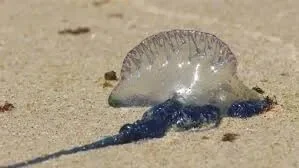Bluebottle stings and first aid
blue bottle on beach
Bluebottle Stings: What You Need to Know and How to Treat Them
This time of year, everyone heading down the coast
The ocean is a place of wonder, adventure, and relaxation but harbours hidden dangers. One of the most common hazards beachgoers face is the sting of a bluebottle, a jellyfish-like marine creature that can pack a painful punch. If you're an ocean lover or enjoy time by the shore, understanding how to manage a blue bottle sting is essential. Gungahlin First Aid provides all the information you need to stay safe and treat stings effectively.
I have personally treated blue bottle stings on my daughter's arms and legs, and then some managed to get to my arm when rescuing her from the water, so I am speaking first-hand what to do.
What Are Bluebottles?
Bluebottles, also known as Portuguese man-of-war in some regions, are marine hydrozoans. While they look like a single organism, they are a colony of specialized polyps working together. The most recognizable feature of a blue bottle is its vibrant blue, balloon-like float on the water’s surface. Its long, trailing tentacles can stretch up to 10 meters (though typically shorter).
Bluebottles are often found in warm, tropical waters but can be swept to shore by winds and ocean currents. Their tentacles contain venom-filled nematocysts, which they use to immobilize prey and defend against predators. Unfortunately, these stinging cells can also cause painful injuries to humans.
Recognizing a Bluebottle Sting
If you've been stung by a blue bottle, you'll likely know it immediately due to the sharp, immediate pain. Symptoms include:
Intense, burning pain at the site of the sting.
Raised, red welts or lines where the tentacle made contact.
Swelling and localized skin irritation.
In some cases, systemic symptoms such as nausea, dizziness, difficulty breathing, or fainting may occur, especially in individuals who are allergic or sensitive to the venom.
First Aid for Bluebottle Stings
Acting quickly and correctly can significantly reduce the severity of symptoms and promote faster recovery. Follow these steps:
1. Remove Tentacles
Gently rinse the area with seawater to remove any remaining tentacles. Avoid using freshwater as it can trigger the release of more venom.
If visible tentacles remain, use tweezers or the edge of a rigid object (like a credit card) to carefully lift them away. Avoid using your bare hands.
2. Avoid Rubbing
Do not rub the affected area, as this can worsen the spread of venom.
Do not use sand or towels to scrape off tentacles.
3. Rinse with Hot Water
Immerse the sting area in hot water (not scalding) for 20-30 minutes, as heat can help deactivate the venom and alleviate pain.
If immersion isn’t possible, apply a hot pack or soak a cloth in hot water and place it over the sting.
4. Pain Management
If pain persists, over-the-counter pain relief medications such as paracetamol or ibuprofen can be used (follow dosage instructions).
Avoid scratching or applying ice directly to the skin, exacerbating irritation.
5. Monitor for Severe Reactions
Watch for signs of an allergic reaction, such as swelling of the face or throat, difficulty breathing, or a rapid heartbeat.
If systemic symptoms develop, seek emergency medical help immediately. Call 000 in Australia or use the Emergency Plus app to share your location accurately with responders.
What Not to Do
It’s essential to debunk some common myths about bluebottle sting treatment:
Do not use vinegar. Vinegar can worsen bluebottle stings, unlike other jellyfish stings, by activating more nematocysts.
Do not pee on the sting. This old wives’ tale is ineffective and can introduce bacteria to the wound.
Avoid alcohol or other home remedies. Stick to tried-and-tested first aid techniques.
Prevention Tips
Prevention is always better than cure. Here are some tips to reduce your risk of encountering bluebottles:
Check Beach Warnings: Lifeguards often post warnings about jellyfish activity. Take note of flags or signs.
Avoid Touching: If you see a blue bottle washed up on the shore, don’t touch it. Even dead ones can sting.
Wear Protective Gear: Rash vests or wetsuits can provide a physical barrier.
Know the Conditions: Bluebottles are more common after onshore winds. Check weather reports before heading to the beach.
When to Seek Medical Attention
While most bluebottle stings are manageable at home, there are situations where professional medical assistance is necessary:
If the sting covers a large area of the body.
Persistent or worsening pain despite first aid treatment.
Signs of infection include increased redness, warmth, or discharge from the sting site.
Severe allergic reactions or systemic symptoms like trouble breathing, fainting, or chest pain.
How Gungahlia First Aid Can Help
At Gungahlia First Aid, we’re committed to empowering individuals with lifesaving knowledge and skills. Our first aid courses include modules on managing marine stings, providing you with hands-on training to handle emergencies confidently. Whether you're a parent, beach enthusiast, or professional working near the water, our courses are tailored to meet your needs.
We also recommend downloading the Emergency Plus app for quick access to emergency services and accurate location sharing, which is crucial during beachside emergencies.
Final Thoughts
Bluebottle stings are a common yet manageable hazard when enjoying the ocean. By understanding the proper first aid techniques and taking preventive measures, you can ensure your time by the water remains a pleasant and safe experience. Stay informed, stay prepared, and let Gungahlia First Aid be your partner in safety.
For more information on first aid courses or marine sting management, contact Gungahlia First Aid today. Make safety your priority!
See you down the coast, and be safe.
p.s. remember, when in doubt, always contact a professional for further advice. This is a first-aid reminder

